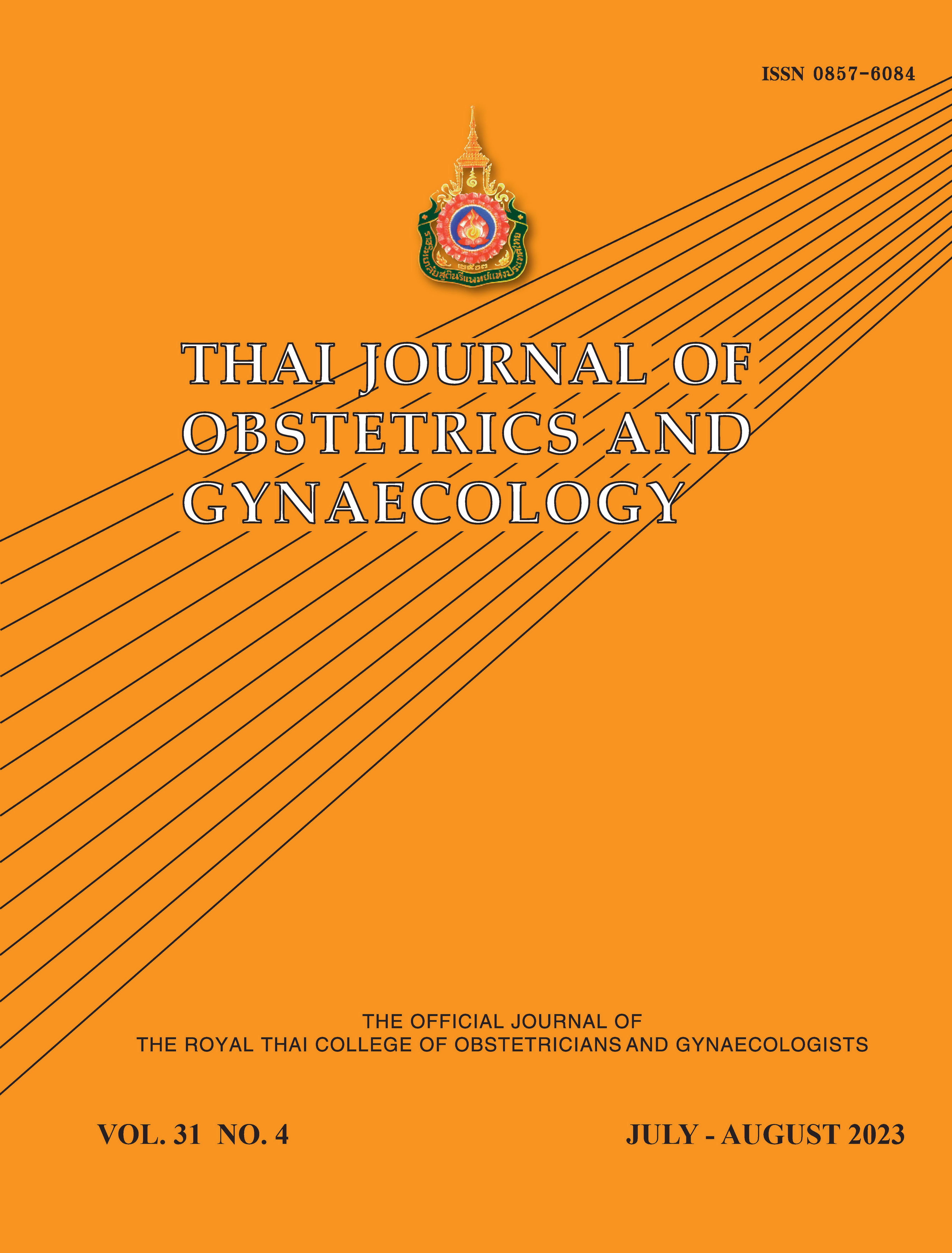Prevalence and Factors Associated with Long-acting Reversible Contraception Initiation in Non-teenage Postpartum Thai Women Attending Siriraj Hospital
Main Article Content
Abstract
Objectives: To determine the prevalence of and factors significantly associated with long-acting reversible contraception (LARC) initiation among non-teenage postpartum women attending Siriraj Hospital.
Materials and Methods: This prospective cross-sectional study was conducted at Family Planning and Reproductive Health Unit during June 2021 to January 2022. Thai women aged 20-45 years who requested postpartum contraception within 8 weeks after delivery were eligible for study enrolment.
Results: Three hundred and seven postpartum women were included, but 3 women were excluded from analysis due to incomplete data. The mean age was 29.1 ± 5.6 years. Pregnancy complications were reported in 101 women (33.2%). The prevalence of postpartum LARC initiation was 27.6% (n = 84). The selected LARC method were, as follows: two-rod implant (11.8%), one-rod implant (10.9%), and intrauterine device (4.9%). Presence of pregnancy complications (adjusted odds ratio [aOR] 3.2, 95% confidence interval [CI] 1.21-8.44; p = 0.019) and interest in LARC (aOR 146.60, 95%CI 44.96-478.00; p < 0.001) were the factors independently associated with postpartum LARC initiation. Concern about the insertion procedure and complications or side effects related to LARC were cited as reasons for not requesting LARC initiation.
Conclusion: The prevalence of postpartum LARC initiation among non-teenage Thai women at our centre was higher than the national prevalence of LARC initiation in Thailand. Presence of pregnancy complications and interest in LARC were identified as independent predictors of postpartum LARC use. The barriers to LARC initiation should be evaluated and managed to increase the rate of LARC utilization among interested women, but who harbour concerns about LARC.
Article Details

This work is licensed under a Creative Commons Attribution-NonCommercial-NoDerivatives 4.0 International License.
References
American College of Obstetricians and Gynecologists, Society for Maternal-Fetal Medicine. Obstetric Care Consensus No. 8: Interpregnancy care. Obstet Gynecol 2019;133:e51-e72.
Department of Reproductive Health and Research (RHR). Report of a WHO Technical Consultation on Birth Spacing: Geneva, Switzerland 13-15 June 2005. Geneva, Switzerland World Health Organization; 2007. Available from: http://apps.who.int/iris/ bitstream/10665/69855/1/WHO_RHR_07.1_eng.pdf. Accessed August 15, 2022.
Conde-Agudelo A, Rosas-Bermúdez A, Kafury-Goeta A. Birth spacing and risk of adverse perinatal outcomes. JAMA 2006;295:1809-23.
Shree R, Caughey AB, Chandrasekaran S. Short interpregnancy interval increases the risk of preterm premature rupture of membranes and early delivery. J Matern Fetal Neonatal Med 2018;31:3014-20.
Hall JA, Benton L, Copas A, Stephenson J. Pregnancy intention and pregnancy outcome: Systematic review and meta-analysis. Matern Child Health J 2017;21:670-704.
Committee on Practice Bulletins-Gynecology, Long-Acting Reversible Contraception Work Group. Practice Bulletin No. 186: Long-Acting Reversible Contraception: Implants and Intrauterine Devices. Obstet Gynecol 2017;130:e251-e69.
Selected practice recommendations for contraceptive use. 3rd ed. Geneva: World Health Organization; 2016.
Committee on Gynecologic Practice Long-Acting Reversible Contraception Working G. Committee opinion No. 642: Increasing access to contraceptive implants and intrauterine devices to reduce unintended pregnancy. Obstet Gynecol 2015;126:e44-8.
National Statistical Office of Thailand. 2020. Thailand Multiple Indicator Cluster Survey 2019, Survey Findings Report. Bangkok, Thailand: National Statistical Office of Thailand.
Akesittipaisarn S, Werawatakul Y, Simsin S. Factors associated with long-acting reversible contraception (LARC) use in postpartum women at srinagarind hospital. Thai J Obstet Gynaecol 2018;26:132-9.
Chansin W, Manonai J, Wattanayingcharonchai R, Aimjirakul K. Postpartum use of long-acting reversible contraception in primiparous women: Ramathibodi hospital’s experiences. Thai J Obstet Gynaecol 2014;22:29-36.
Woldu BF, Ermolo TL, Lemu LG, Gejo NG. Long-acting reversible contraception utilization and associated factors among women in extended postpartum period in Hossana town, southern Ethiopia: cross sectional study. Contracept Reprod Med 2020;5:10.
Oduyebo T, Zapata LB, Boutot ME, Tepper NK, Curtis KM, D’Angelo DV, et al. Factors associated with postpartum use of long-acting reversible contraception. Am J Obstet Gynecol 2019;221:43 e1- e11.
Mesfin Y, Wallelign A. Long-acting reversible contraception utilization and associated factors among women in extended postpartum period in southern Ethiopia. Arch Public Health 2021;79:161.
Kang C, Li P, Liu X, Ding Y, Wang X, Zhou H. Use of contraceptives and uptake of long-acting reversible contraception among postpartum women in rural China. BMJ Sex Reprod Health 2018;44:254-9.
Kiondo KS, Maro E, Kiwango S, Alloyce JP, Shayo BC, Mahande MJ. Prevalence and factors associated with postpartum use of long-acting reversible contraception in Bukombe District, Geita Region, Tanzania: a community- based study. Contracept Reprod Med 2020;5:24.
Chaovisitsaree S, Noi-um S, Kietpeerakool C. Review of postpartum contraceptive practices at Chiang Mai University Hospital: implications for improving quality of service. Med Princ Pract 2012;21:145-9.
Medical eligibility criteria for contraceptive use. Fifth Edition 2015. WHO Guidelines Approved by the Guidelines Review Committee. Available from: http://www.who.int/reproductivehealth/publications/family_planning/MEC-5/en/. Accessed August 15, 2022.
Jaruamornjit Y, Kaewrudee S, Sothornwit J. Differences in postpartum contraceptive choices and patterns following low- and high-risk pregnancy. Contraception 2022;107:52-7.
Zerden ML, Tang JH, Stuart GS, Norton DR, Verbiest SB, Brody S. Barriers to receiving long-acting reversible contraception in the postpartum period. Womens Health Issues 2015;25:616-21.
Nelson HN, Thayer E, Bailey C, Leuenberger L, Lehman E, Chuang CH. Factors associated with new uptake of long-actingr reversible contraceptives since the affordable care act among privately insured women in pennsylvania. Womens Health Issues 2019;29: 370-5.
Sothornwit J, Lumbiganon P, Saranrittichai K, Sangkomkamhang U, Singhdaeng T, Jampathong N. Barriers and facilitators to implementing immediate postpartum contraceptive implant programs: A formative implementation research. Int J Womens Health 2022;14:945-56.


